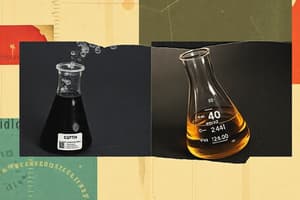Podcast
Questions and Answers
What is equilibrium in chemistry?
What is equilibrium in chemistry?
- When forward reaction rate is faster than reverse reaction rate
- The imbalance between reactants and products
- The balance between reactants and products where forward and reverse reactions occur at equal rates (correct)
- When reactants are completely consumed
In a reversible reaction, what happens when equilibrium is reached?
In a reversible reaction, what happens when equilibrium is reached?
- All reactants are converted to products
- The forward reaction stops completely
- There is no equilibrium in reversible reactions
- The rate of formation of products equals the rate of formation of reactants (correct)
Which of the following factors can influence a reversible reaction?
Which of the following factors can influence a reversible reaction?
- Color of the reactants
- Volume of the reactants
- Pressure only
- Concentration, temperature, and pressure (correct)
Le Chatelier's principle provides guidance on how systems at equilibrium respond to changes in which variables?
Le Chatelier's principle provides guidance on how systems at equilibrium respond to changes in which variables?
When a system at equilibrium is disturbed by a change, how does it respond according to Le Chatelier's principle?
When a system at equilibrium is disturbed by a change, how does it respond according to Le Chatelier's principle?
In a reversible reaction system, when does equilibrium occur?
In a reversible reaction system, when does equilibrium occur?
What happens when you increase the initial concentration of reactants in a reaction?
What happens when you increase the initial concentration of reactants in a reaction?
How does a decrease in temperature affect the equilibrium of a reaction?
How does a decrease in temperature affect the equilibrium of a reaction?
What is the effect of increasing pressure on reactions involving gaseous species?
What is the effect of increasing pressure on reactions involving gaseous species?
Why is understanding equilibria important in practical situations?
Why is understanding equilibria important in practical situations?
What is a primary factor affecting equilibrium mentioned in the text?
What is a primary factor affecting equilibrium mentioned in the text?
What can changing the concentration of products lead to in a reaction?
What can changing the concentration of products lead to in a reaction?
Study Notes
Equilibrium in Chemistry Class 11
Equilibrium is one of the fundamental concepts you'll encounter when studying chemistry during your Grade 11 journey. In essence, it refers to the balance between reactants and products within a chemical reaction system where both forward and reverse reactions occur at equal rates. This delicate dance plays out over time until the concentrations reach a stable point known as equilibrium. Let's take a closer look at this concept by examining some key aspects of equilibrium in chemistry class 11.
Reversible Reactions
A reversible reaction can proceed either forward or backward depending on conditions like temperature, concentration, or pressure. For example, consider the reaction between nitrogen gas (N₂) and hydrogen gas (H₂) to form ammonia (NH₃):
[ \mathrm{~N}_2 (\mathrm{~g}) + 3 \mathrm{~H}_2(\mathrm{~g}) \rightleftharpoons 2 \mathrm{~NH}_3\left( \mathrm{~g} \right)]
In this case, the reaction has reached equilibrium when the rate of formation of NH₃ equals its rate of decomposition into its constituent gases.
Le Chatelier's Principle
Le Chatelier’s principle provides guidance on how systems at equilibrium respond to changes in variables such as concentration, temperature, or pressure. When a change occurs, the system adjusts itself to counteract the change so that once again, an equilibrium state exists. To put it simply, if you increase the initial concentration of reactants, more product will be formed; conversely, increasing the product concentration leads to more reactant formation.
Factors Affecting Equilibrium
The three primary factors affecting equilibrium are:
- Concentration: As mentioned earlier, changing the concentration of reactants and products affects the position of equilibrium.
- Temperature: An increase in temperature generally causes the equilibrium to shift towards lower enthalpy states (forward direction), while a decrease shifts it towards higher enthalpy states (reverse direction). However, note that this may not always hold true due to other effects like entropy.
- Pressure: For reactions involving gaseous species, changes in total pressure affect the positions of equilibrium. Increasing pressure tends to favor the side with fewer moles of gas, whereas decreasing pressure favors the side with more moles.
Applications of Equilibrium
Understanding equilibria is crucial because many practical situations involve applying these principles to solve real-world problems related to catalysts, buffers, acidity constants, solubility, etc.. By manipulating various parameters, we can optimize processes like fermentation, purification techniques, and waste treatment. Hence, learning about equilibrium provides essential knowledge useful beyond school curriculum boundaries!
Remember, grasping the fundamentals laid out here will empower you to excel further as you dive deeper into complex topics across multiple branches of chemistry. Good luck on your science adventure!
Studying That Suits You
Use AI to generate personalized quizzes and flashcards to suit your learning preferences.
Description
Explore the fundamental concepts of equilibrium in chemistry class 11, focusing on reversible reactions, Le Chatelier's principle, factors affecting equilibrium, and practical applications of this critical chemical concept. Enhance your understanding of how reactants and products reach a stable state of balance within a chemical reaction system.




